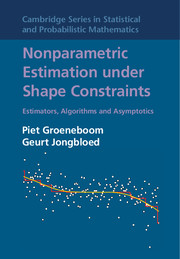Book contents
- Frontmatter
- Contents
- Preface and Acknowledgments
- 1 Introduction
- 2 Basic Estimation Problems with Monotonicity Constraints
- 3 Asymptotic Theory for the Basic Monotone Problems
- 4 Other Univariate Problems Involving Monotonicity Constraints
- 5 Higher Dimensional Problems
- 6 Lower Bounds on Estimation Rates
- 7 Algorithms and Computation
- 8 Shape and Smoothness
- 9 Testing and Confidence Intervals
- 10 Asymptotic Theory of Smooth Functionals
- 11 Pointwise Asymptotic Distribution Theory for Univariate Problems
- 12 Pointwise Asymptotic Distribution Theory for Multivariate Problems
- 13 Asymptotic Distribution of Global Deviations
- References
- Author Index
- Subject Index
Preface and Acknowledgments
Published online by Cambridge University Press: 18 December 2014
- Frontmatter
- Contents
- Preface and Acknowledgments
- 1 Introduction
- 2 Basic Estimation Problems with Monotonicity Constraints
- 3 Asymptotic Theory for the Basic Monotone Problems
- 4 Other Univariate Problems Involving Monotonicity Constraints
- 5 Higher Dimensional Problems
- 6 Lower Bounds on Estimation Rates
- 7 Algorithms and Computation
- 8 Shape and Smoothness
- 9 Testing and Confidence Intervals
- 10 Asymptotic Theory of Smooth Functionals
- 11 Pointwise Asymptotic Distribution Theory for Univariate Problems
- 12 Pointwise Asymptotic Distribution Theory for Multivariate Problems
- 13 Asymptotic Distribution of Global Deviations
- References
- Author Index
- Subject Index
Summary
Research on nonparametric estimation under shape constraints started in the 1950s. Papers such as Ayer et al., 1955, and Van Eeden, 1956, appeared on estimation of functions under the restriction of monotonicity or unimodality, more generally called isotonic estimation. An isotonic estimator is an estimator that is computed under an order restriction, where the order can be a partial order. The order restriction can also be imposed on the derivative of the estimator, so an estimator of a convex function (in dimension one or higher), which is itself also convex, is also called an isotonic estimator.
A summary of the early work was given in the well-known book by Barlow et al., 1972, on isotonic regression. Originally, the focus was on defining and constructing estimators satisfying these order constraints. As an example, in Grenander, 1956, it is shown that the (nonparametric) maximum likelihood estimator (MLE) of a monotone decreasing density can be constructed as the left-continuous slope of the least concave majorant of the empirical distribution function. Developing asymptotic distribution theory for these isotonic estimators turned out to be rather difficult. Nonnormal limit distributions appear and rates of convergence are slower than the square root of the sample size. This behavior is now commonly classified as belonging to the area of nonstandard asymptotics. In the case of the mentioned Grenander MLE, the rate of convergence of this estimator (evaluated at a fixed point, under some local assumptions) is the cube root of the sample size. Moreover, the nonnormal asymptotic distribution of the estimator is (after rescaling) the so-called Chernoff distribution, which is (up to a factor 2) the distribution of the derivative of the greatest convex minorant of two-sided Brownian motion with parabolic drift, evaluated at zero.
Research on isotonic regression received new impetus in the 1990s when it became clear that it was the right setting for studying (nonparametric) MLEs of the distribution function in inverse problems.
Information
- Type
- Chapter
- Information
- Nonparametric Estimation under Shape ConstraintsEstimators, Algorithms and Asymptotics, pp. ix - xiiPublisher: Cambridge University PressPrint publication year: 2014
